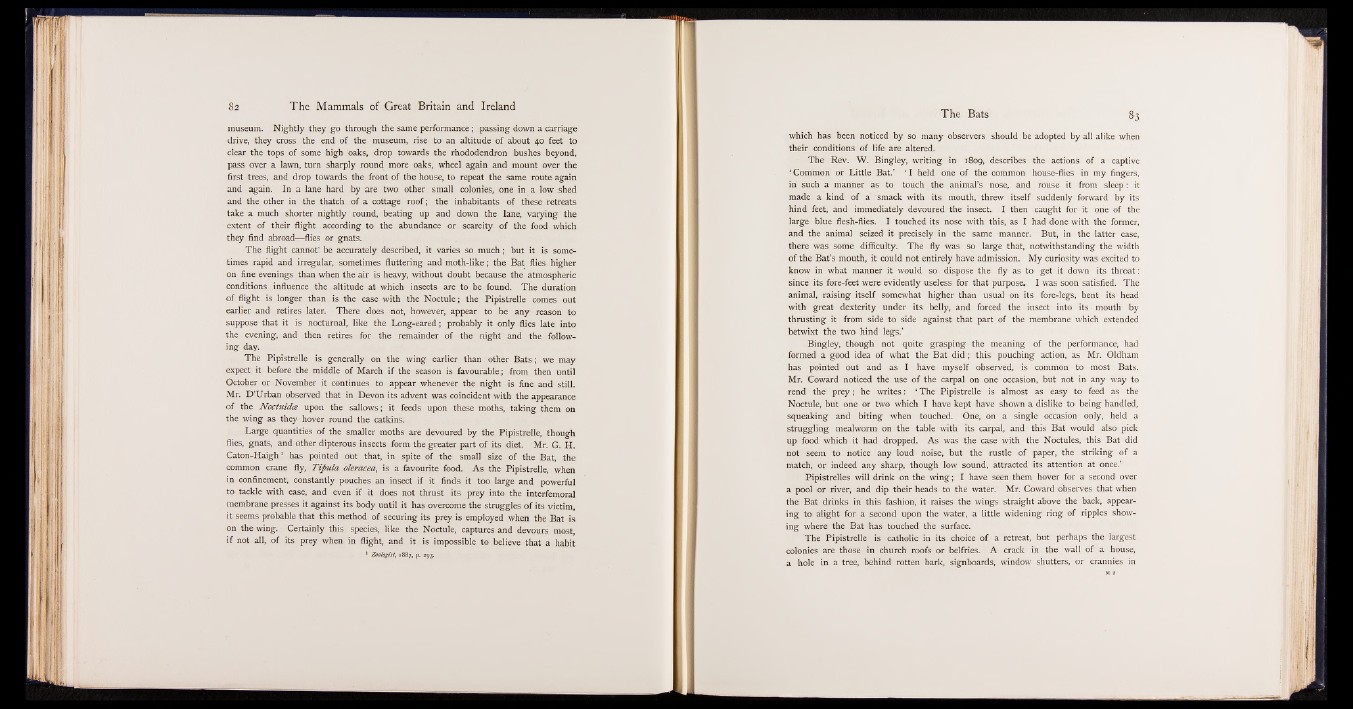
museum. Nightly they go through the same performance; passing down a carriage
drive, they cross the end of the museum, rise to an altitude of about 40 feet to
clear the tops of some high oaks, drop towards the rhododendron bushes beyond,
pass over a lawn, turn sharply round more oaks, wheel again and mount over the
first trees, and drop towards the front of the house, to repeat the same route again
and again. In a lane hard by are two other small colonies, one in a low shed
and the other in the thatch of a cottage roof; the inhabitants of these retreats
take a much shorter nightly round, beating up and down the lane, varying the
extent of their flight according to the abundance or scarcity of the food which
they find abroad— flies or gnats.
The flight cannot', be accurately described, it varies so much; but it is sometimes
rapid and irregular, sometimes fluttering and moth-like; the Bat flies higher
on fine evenings than when the air is heavy, without doubt because the atmospheric
conditions influence the altitude at which insects are to be found. The duration
of flight is longer than is the case with the Noctule; the Pipistrelle comes out
earlier and retires later. There does not, however, appear to be any reason to
suppose that it is nocturnal, like the Long-eared; probably it only flies late into
the evening, and then retires for the remainder of the night and the following
day.
The Pipistrelle is generally on the wing earlier than other Bats; we may
expect it before the middle of March if the season is favourable; from then until
October or November it continues to appear whenever the night is fine and still.
Mr. D’Urban observed that in Devon its advent was coincident with the appearance
of the Noctuidce upon the sallows; it feeds upon these moths, taking them on
the wing as they hover round the catkins.
Large quantities of the smaller moths are devoured by the Pipistrelle, though
flies, gnats, and other dipterous insects form the greater part of its diet. Mr. G. H.
Caton-Haigh1 has pointed out that, in spite of the small size of the Bat, the
common crane fly, Tipula oleracea, is a favourite food. As the Pipistrelle, when
in confinement, constantly pouches an insect if it finds it too large and powerful
to tackle with ease, and even if it does not thrust its prey into the interfemoral
membrane presses it against its body until it has overcome the struggles of its victim,
it seems probable that this method of securing its prey is employed when the Bat is
on the wing. Certainly this species, like the Noctule, captures and devours most,
if not all, of its prey when in flight, and it is impossible to believe that a habit
1 Zoologist1887, p. 293.
The Bats 83
which has been noticed by so many observers should be adopted by all alike when
their conditions of life are altered.
The Rev. W. Bingley, writing in 1809, describes the actions of a captive
‘ Common or Little Bat.’ ‘ I held one of the common house-flies in my fingers,
in such a manner as to touch the animal’s nose, and rouse it from sleep: it
made a kind of a smack with its mouth, threw itself suddenly forward by its
hind feet, and immediately devoured the insect* I then caught for it one of the
large blue flesh-flies. I touched its nose with this, as I had done with the former,
and the animal seized it precisely in the same manner. But, in the latter case,
there was some difficulty. The fly was so large that, notwithstanding the width
of the Bat’s mouth, it could not entirely have admission. My curiosity was excited to
know in what manner it would so dispose the fly as to get it down its throat:
since its fore-feet were evidently useless for that purpose. I was soon satisfied. The
animal, raising itself somewhat higher than usual on its fore-legs, bent its head
with great dexterity under its belly, and forced the insect into its mouth by
thrusting it from side to side against that part of the membrane which extended
betwixt the two hind legs.’
Bingley, though not quite grasping the meaning of the performance, had
formed a good idea of what the Bat did ; this pouching action, as Mr. Oldham
has pointed out and as I have myself observed, is common to most Bats.
Mr. Coward noticed the use of the carpal on one occasion, but not in any way to
rend the prey; he writes: ‘ The Pipistrelle is almost as easy to feed as the
Noctule, but one or two which I have kept have shown a dislike to being handled,
squeaking and biting when touched. One, on a single occasion only, held a
struggling mealworm on the table with its carpal, and this Bat would also pick
up food which it had dropped. As was the case with the Noctules, this Bat did
not seem to notice any loud noise, but the rustle of paper, the striking of a
match, or indeed any sharp, though low sound, attracted its attention at once.’
Pipistrelles will drink on the wing; I have seen them hover for a second over
a pool or river, and dip their heads to the water. Mr. Coward observes that when
the Bat drinks in this fashion, it raises the wings straight above the back, appearing
to alight for a second upon the water, a little widening ring of ripples showing
where the Bat has touched the surface.
The Pipistrelle is catholic in its choice of a retreat, but perhaps the largest
colonies are those in church roofs or belfries. A crack in the wall of a house,
a hole in a tree, behind rotten bark, signboards, window shutters, or crannies in